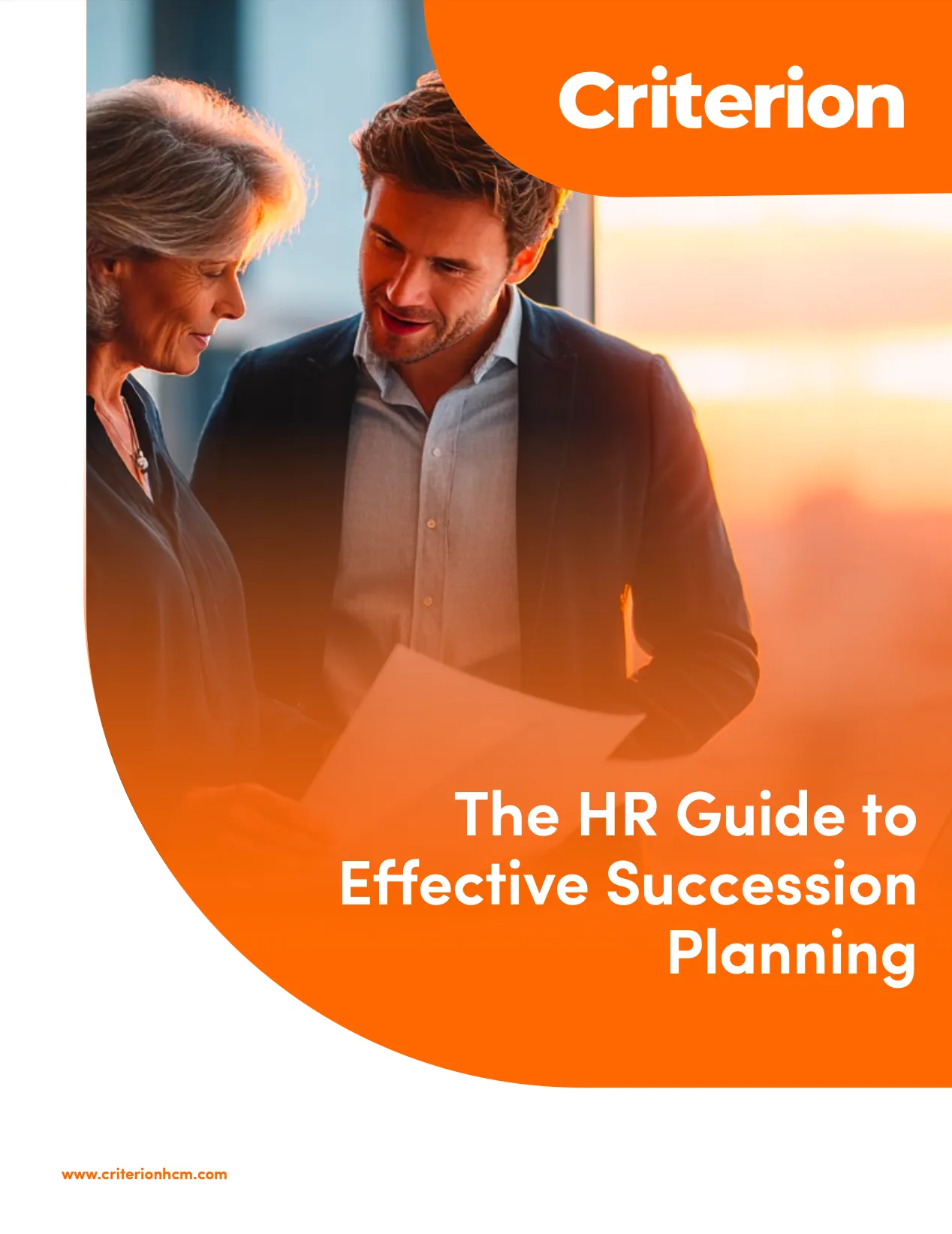Senior employee transitions may look routine, but when they go wrong, the cost is steep. Studies show that poorly managed C-suite successions destroy nearly $1 trillion in market value each year across S&P 1500 companies.
But that kind of loss doesn’t come from a single bad hire. It happens when organizations leave the hiring of critical roles (like CEO, CFO, or project executive) up to last-minute searches or guesswork.
As boomer retirements are accelerating, many organizations already struggle to fill skilled roles. But handing the reins to an unprepared successor can stall big projects and cost a lot of money. Many times, the best successor is an insider who already knows the company’s culture, customers, and playbook. Finding and preparing that talent is the heart of succession planning — the process of identifying and training specific employees to step into key high-level roles whenever they open up.
Let’s look at how to execute an effective succession planning process, why it protects your bottom line, and the steps HR leaders can take to build a high-quality talent bench. That way, you’re never blindsided when a key person walks out the door.
{{inline-cta-products-hr="/style-guide"}}
What Is Succession Planning?
Succession planning is an ongoing process for keeping critical jobs filled within an organization. It works by identifying high-potential employees and giving them everything they need (targeted coaching, stretch assignments, knowledge transfer, etc.) to take over key senior-level roles when they open (usually from retirement or promotions). This means continuously tracking the employee’s readiness so they can step smoothly into these roles without disrupting operations or compliance.
Of course, any time a higher-level employee leaves, that organization usually has to hire a replacement. But while typical backfilling starts after someone resigns, succession planning starts years earlier. Done well, succession planning builds a learning culture and increases loyalty (and retention) by consistently investing in career growth across the company. It also reduces costs related to hiring, training, and onboarding for external candidates.
Why Succession Planning Matters
If your CEO quit tomorrow, would you be ready?
Without a succession plan in place, most organizations scramble to respond. The pressure to act fast leads to rushed decisions and risky hires. In some cases, companies end up paying more for a lower-quality hire, and damaging trust with employees, investors, and customers.
In fact, a study from PWC found that large companies that experienced unplanned CEO successions could have generated $112 billion more in market value across the year before and after the transition — if only they’d had a proper plan in place.
Let’s break down what’s at stake.
Business Continuity
Every senior executive carries years (sometimes decades) of institutional knowledge, vendor relationships, workflows, and informal decision-making patterns. When those people leave, they often take all of that with them.
Succession planning protects you from that loss. It gives you time to document critical processes, cross-train team members, and ensure successors can step in with minimal disruption.
Talent Retention and Morale
People are more likely to stay with an employer when they see a clear path forward. Investing in employees and giving them real opportunities to grow into leadership roles builds loyalty and increases retention. Plus, when well-respected leaders leave, the impact can be extensive. Morale can dip, and others may follow, causing greater attrition. Preparing successors who are already trusted members of the team helps maintain stability and can even rebuild confidence.
Cost Savings
External hires don’t just take longer to onboard. They cost more, too. Research from Wharton professor Matthew Bidwell found that external hires are paid about 18–20% more than internal promotions — but receive lower performance evaluations on average.
Succession planning keeps costs down by building a reliable internal pipeline. You reduce recruiting spend, shorten time-to-productivity, and avoid expensive mistakes.
Board and Investor Confidence
Leadership transitions can also affect your brand reputation. Boards, stakeholders, and partners want to know your organization has a plan for continuity. A thoughtful, well-communicated succession strategy signals stability and long-term vision, especially during times of change.
Whether you're in education, engineering, or government, the risks of doing nothing are too high. A strong succession plan keeps your people, projects, and momentum intact.
{{inline-cta-wp-internal-mobility="/style-guide"}}
Who Owns Succession Planning?
Succession planning may live in HR, but it’s not just an HR responsibility. It takes a shared commitment across teams to succeed.
HR Leads the Process (But Can’t Do It Alone)
HR plays a key role in talent and succession planning by:
- Facilitating skills assessments
- Coordinating development programs
- Tracking progress across roles and departments
- Identifying key roles and tracking when they are likely to become vacant
But without executive buy-in (or help from other sources), even the best HR-led plan won’t stick. Leaders need to do more than approve documents. They should actively participate by mentoring successors and shaping career paths. In other words, the whole organization needs to have regular strategic conversations about succession.
Building a Culture of Succession
The strongest succession plans go far beyond a one-off exercise — they’re part of the organization’s culture.
Career frameworks can support this mindset. These structured paths help employees envision a satisfying future with the company, especially when introduced early. When employees understand how they can grow from day one, they’re more likely to stay engaged and motivated to lead later on.
Regular leadership and talent reviews also reinforce this culture. Some organizations go a step further by forming succession planning committees (teams that share insights and align development efforts across departments).
Involving Department Heads
The CEO and executive team should treat leadership continuity as a business priority, not just an HR initiative. Unfortunately, many still fall short. One study found that only 47% of companies have a formal CEO succession contingency plan in place.
Succession planning works best when managers and department leaders help identify and grow talent within their own teams. This type of leader is in a unique position to spot potential before it shows up on a spreadsheet. They also understand the technical and soft skills needed for success in specific roles.
Tools That Bring It All Together
A centralized workforce management platform keeps HR and leadership aligned on the same goals. It makes it easier to:
- Manage positions and employee experience
- Track development plans, certifications, and progress over time
- Spot gaps early — before they become emergencies
- Uncover trends and forecast needs through AI-powered workforce analysis
With better visibility and data-driven processes, it’s easier to act and to adjust as your business evolves.
How To Execute a Strong Succession Plan (Step-by-Step)
Succession planning isn’t just about naming a replacement — it’s about preparing the right people, at the right time, to step into critical roles with confidence. While every organization is different, the most effective ones follow a clear, repeatable process. Here are 6 steps to put that plan into action.
1. Assess Organizational Needs
Before identifying individual successors, start by looking ahead. What will your organization need in the next 3, 5, or 10 years? Are you expanding into new markets? Retiring key staff? Launching new services or adapting to new technology?
Succession planning should be closely tied to your strategic workforce planning. Begin by aligning business goals with the positions and competencies required to achieve them. This ensures you’re developing people not just for current vacancies, but for tomorrow’s leadership challenges.
For example, if you plan to build an entirely new department, talent and succession planning should be built into that initiative. High-performing employees (possibly future leaders) may move into those new roles, which can shrink your bench for existing department leadership. Planning ahead helps you stay flexible and avoid unexpected gaps.
2. Identify Critical Roles
Next, identify the positions that would seriously impact your business if left open. Consider positions that:
- Are vital to core operations, revenue, or long-term strategy
- Would hurt the business if left unfilled for even a short time
- Hold unique or siloed knowledge (especially if that knowledge isn’t documented anywhere)
“Critical” roles often go beyond the C-suite. Management roles or specialized positions two or three levels down can be just as essential. For example, a retiring payroll manager who understands a legacy system better than anyone else could leave a major gap if no one is prepared to step in.
Build a company-wide inventory of these high-risk roles. A custom report (listing the role, current incumbent, successor candidates, and development status) can keep everyone aligned and make it easy to share updates with stakeholders.
3. Find High-Potential Talent
Next, define the specific qualifications needed for success in each role and identify employees with the potential to step into those roles. A solid organization structure helps here by providing clarity on responsibilities and reporting lines.
To qualify candidates, look at performance reviews, KPIs, and manager input. Highlight future leaders — especially those who show initiative and a desire to grow.
Avoid defaulting to seniority. Sometimes, the best fit for a future role is someone in a junior position who’s already demonstrating the mindset and skills needed. Also, make sure to prioritize diversity. Organizations that look beyond the usual suspects build stronger, more balanced leadership benches.
Todd & Sargent, a leader in slip-form construction, used Sage HCM’s position history features to help identify and promote experienced leaders for highly specialized roles. Their HR team can now track role transitions and project assignments across teams with greater precision.
4. Prioritize Development and Mentoring
Once you've identified your high-potential talent, map out individualized development plans (IDPs) to get them ready.
Common learning and development strategies include:
- Formal succession training programs
- Stretch assignments
- Mentorship from current role-holders
- Industry certifications
- Coaching
- Independent learning
Track their progress and reassess periodically. Development isn’t one-size-fits-all. Some employees may need deeper technical knowledge, while others require leadership or business acumen. It all depends on where the person is starting from.
Mentorship programs are especially effective here. They provide access, visibility, and support that can help rising talent gain the confidence and preparation needed to lead.
5. Establish a Clear Process
Even with the right people and training in place, leadership transitions can fall apart without a defined structure. A well-written succession plan should include:
- A list of all critical roles
- Potential successors and their estimated readiness timeline
- Development actions in progress
- Contingency plans in case someone leaves unexpectedly
Include overlap periods where the outgoing leader supports the incoming bench, along with time-bound goals and regular check-ins (quarterly or biannually) to track their progress toward readiness.
A unified HCM platform makes this easier. With employee data and learning management in one place, you can create custom workflows, set up automated reminders, and tailor development steps to each employee’s stage in the process.
6. Document and Revise the Plan
At least once a year, formally review your succession plan. This is a chance to add or remove candidates, revise development paths, and reassess critical roles and responsibilities.
Some elements like your SOPs may not need frequent changes. However, you may also find that changing parts of your organization structure is the best way to solve an attrition problem.
In any case, your people will grow, your teams will shift, and your business will evolve. Treat succession planning as a living process, not a one-time project for resignations. When done right, it becomes a core part of your workforce management strategy.
{{inline-cta-products-talent="/style-guide"}}
Succession Planning Best Practices
Building a great succession plan creates a repeatable, strategic process that supports your people and your business over the long haul. Here are some best practices that help organizations execute the process more effectively.
Start Early and Make the Process Continuous
One of the biggest mistakes organizations make is waiting until an employee leaves to start thinking about a plan. In reality, succession planning should begin long before a role opens up. The earlier you start, the better. This allows time for valuable knowledge transfer. You don’t want successors to just fill a seat, but to fully understand the nuances and processes involved in the role.
Succession planning should also evolve as your business grows. That means updating your plan with new performance data, team changes, and business priorities — not treating it as a static document. Think of it as a long-term investment in resilience, not a one-time crisis response.
Align With Business Strategy
Succession planning doesn’t happen in a vacuum. It works best when reflecting where your organization is expected to be several years down the line.
For example, if your company is focused on digital transformation, then future leaders should have tech fluency. That starts early: during hiring, onboarding, and development. Identify the skills and mindsets your future organization will need, and build your plan accordingly.
Promote Diversity and Inclusion
Your leadership pipeline should reflect the diversity of both your workforce and the communities you serve. Otherwise, you’ll risk reinforcing existing gaps in representation and missing out on high-potential talent.
To build a more equitable leadership structure, start by removing bias from the process:
- Use clear, role-specific criteria to assess potential. Focusing on skills, readiness, and growth capacity rather than tenure or personal familiarity.
- Aim to include a diverse bench of successors for every critical role. You can generate reports to ensure you have a good mix of people from different departments and backgrounds on the bench for consideration.
- Be intentional about creating development opportunities. Pay attention to employees who may not have had access to these opportunities in the past.
Be Transparent and Manage Expectations
You don’t need to broadcast your entire plan, but some transparency goes a long way. Let employees know:
- There’s a succession process in place
- They can be considered for future roles
- Development opportunities are open
Clear communication boosts morale and trust. On the other hand, secrecy can cause frustration, resentment, or even attrition (especially if high performers feel overlooked).
Avoid the perception of favoritism by tying promotions to performance, development, and readiness (not company politics).
Measure Outcomes
You can’t improve what you don’t track. Keep an eye on metrics like:
- Percentage of key roles filled internally
- Turnover rate among high-potential employees
- Strength and depth of internal candidate pool
These indicators help you spot weak points in your pipeline and improve your process over time. Over time, your succession strategy should get smarter and more responsive to your organization’s needs.
Leveraging Technology for Succession Planning
For many organizations, succession planning either lives in a spreadsheet or doesn’t exist at all. But that setup carries a lot of risk. When plans are scattered across documents and departments, it becomes nearly impossible to make timely, informed decisions when an employee leaves.
Luckily, the right software can change all of that.
For mid-sized and enterprise organizations, technology doesn’t replace human judgment, but it makes the process more efficient, consistent, and scalable.
How HR Software Helps with Succession Planning
An HRIS or HCM system simplifies talent and succession planning by giving you full visibility into your workforce and org chart all in one place. It takes a lot of guesswork out of key internal hiring decisions.
Here are some notable features to look out for:
- Central employee life profiles: Keep performance reviews, skills, certifications, and career goals in one place. This makes it easier to spot the right people for the right roles and identify what they need to get there.
- Talent succession analytics: Understand who’s “ready” now and who’s still developing. Some tools can even alert you when a critical role lacks a viable successor.
- Development tracking: Monitor each potential successor’s progress on their individual development plan, and prompt managers to follow up with coaching, mentorship, or check-ins.
- Scenario planning: Model “what-if” situations, such as who could step in tomorrow if a VP or project lead left. This helps you identify gaps and take action before problems arise.
- Custom reports: Ensure your leadership pipeline supports your goals by tracking representation, diversity of experience, and other key factors.
Sage HCM’s Approach
Sage HCM brings all of these capabilities together in one configurable, enterprise-level platform. With Sage HCM, you can connect your succession planning efforts to the rest of your HR data for a more seamless experience.
Key features:
- Position management tools to visualize your org structure and map potential backups
- Talent engagement tools that help identify high performers ready for growth
- AI-powered learning recommendations to guide employees toward the next best step in their development
- Integrated employee profiles that track everything from certifications and training to performance and career aspirations
Plus, Sage HCM is designed to be highly configurable to adapt to the unique processes and compliance requirements of your industry. It’s an HR system that works for you (not the other way around).
Final Thoughts
A good succession plan sends a message: your organization grows its own leaders.
Succession planning is about investing in your organization’s long-term strength. Whether you’re running a construction firm, managing a nonprofit, or leading a city department, you need: a resilient leadership pipeline that won’t break when an employee moves on.
Evaluate where you stand at this moment. Do you have successors identified for your top five critical roles? If not, now is the time to start. You don’t want to be among the 55% of organizations with no plan in place for emergency transitions.
Sage HCM helps you turn your succession plan into succession action. Our platform makes it easy to identify top internal talent, map out their growth paths, track readiness, and support managers with the tools they need to stay engaged. Access all of your employee and talent data from one unified system, and fully integrate it with other platforms to put people at the center of your operations.
Book a demo to see how Sage HCM can support your team’s future, starting today.







